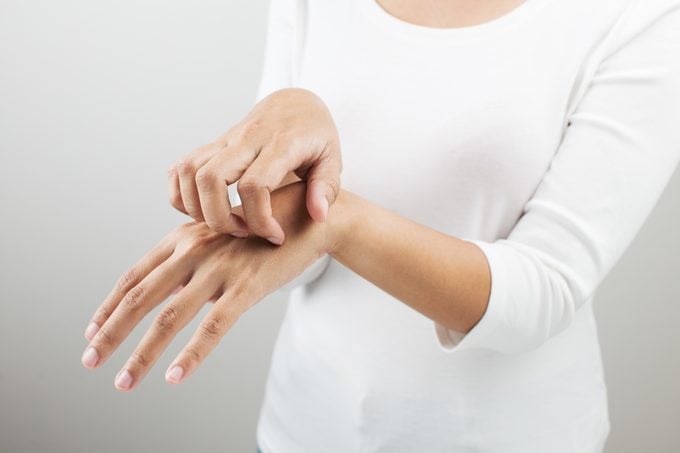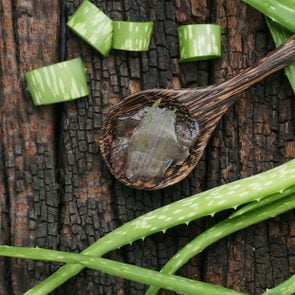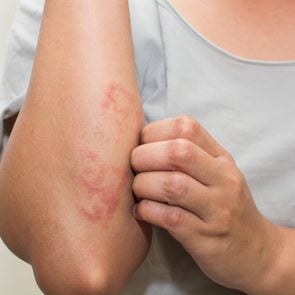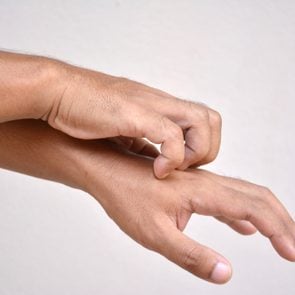I Had Dyshidrotic Eczema Symptoms for Years Before Getting a Diagnosis
Updated: Sep. 29, 2020
Some people sweat or hyperventilate when they're stressed out. Me? I get tiny itchy bumps all over the edges of my fingers, which are actually dyshidrotic eczema symptoms.
I had eczema on my hands
The first time I remember getting the bumps on my hands was right before I went on stage to present my award-winning project at the state science fair when I was 12 years old. I could barely see the tiny firm bumps that had popped up along the edges of my fingers but I could tell they were there because they itched terribly and even kind of stung and burned.
I had no idea where they’d come from, they hadn’t been there that morning, and I began to worry I’d accidentally touched some other kid’s science fair project on toxic frogs or something. I didn’t have time to think much more about it, however, as they called my name and I had to swallow my nerves and step into the spotlight.
In the years since I never won another science award (sorry, Mom and Dad) but I’ve certainly had more instances of the “stress bumps,” as I came to call them thanks to their propensity to show up suddenly under times of serious stress.
They appeared right before big tests, gymnastic meets, public speaking events, and work meetings. They always appeared before a big trip. Oh and my first date? Well, let’s just say no hand-holding happened. Sometimes they popped up for seemingly no reason at all other than to annoy the heck out of me.
For a while I worried that they were warts but they went away as quickly as they appeared, usually within a day or two after the stressful event. (Like these 8 weird symptoms you didn’t realize were linked to stress.)
Because they were so intermittent and random, I mostly just forgot about them unless I was having a flare-up. Out of sight, out of mind. Then one day, when I was about 35 years old, the bumps surprised me in the middle of the night, itching so badly they woke me up. I decided it was time to get answers. I googled “tiny itchy bumps on finger edges.”
The first result I got was “dyshidrotic eczema,” with a picture of somebody’s toes… covered in bumps that I instantly recognized. I had eczema?

What is dyshidrotic eczema?
“Dyshidrotic eczema is a type of eczema characterized by small, intensely itchy clusters of blisters that occur only on the hands and feet. It’s caused by the same inflammation in the body that causes eczema elsewhere, but the skin on our hands and feet is thick enough that it forms blisters that stay intact,” says Jacob Whitsitt, MD, a dermatologist with UCHealth Dermatology Clinic – Cherry Creek. (I can personally vouch for the “intensely” itchy part, it’s miserable.)
It’s more common that most people think—one in 10 people will develop some type of eczema in their lifetime—but exact numbers for dyshidrotic eczema are hard to pin down, mainly because, like me, patients often don’t seek a diagnosis or treatment just for this condition, says Jessica Hui, MD, a pediatrician and researcher in allergy and immunology at National Jewish Health in Denver, Colorado.
Symptoms and diagnosis
There’s really only one symptom of dyshidrotic eczema: the stupid bumps. The blisters are primarily itchy but may also hurt, sting, or burn and they only appear on the palms of your hands, soles of your feet, and edges of your fingers and toes, Dr. Whitsitt says.
You can have a single flare-up of dyshidrotic eczema, but it’s more common for it to come and go over long periods of time, he adds.
“The blisters often feel firm and are not easily ruptured and are sometimes likened to tapioca pudding when describing the size of the blisters most commonly seen,” he explains.
Diagnosis is usually done by a visual exam and a report of your symptoms but it’s very often mis- or under-diagnosed. Most people likely don’t seek treatment and therefore never get a diagnosis because it’s easily mistaken for other blister-causing conditions.
It also tends to come and go so it’s easier to ignore than other skin conditions, Dr. Whitsitt says. Plus, unlike other hand/foot eczema, there will not always be persistent scaly dry patches on the hands and feet to guide diagnosis, he adds.
I did end up getting my dyshidrotic eczema confirmed by a dermatologist—when I went in for a mole check and finally remembered to bring it up and ask her.
What causes dyshidrotic eczema?
The actual cause of dyshidrotic eczema isn’t known but it is more common in people who have another form of eczema, allergies, and/or asthma, and are between 20 and 40 years old, Dr. Hui says. It also tends to run in families, suggesting a genetic component, according to the National Eczema Foundation.
The blisters can be triggered by a variety of things and emotional stress is at the top of the list. Other known triggers include exposure to certain metals, like nickel, seasonal allergies, hot and humid weather, large changes in temperature, and some chemicals, like fragrances in hand lotion.
It varies from patient to patient so learning your personal triggers is one of the best things you can do to help yourself, Dr. Hui says.
However, I can tell you from personal experience that sometimes there’s no trigger at all and the little devils show up just because they can.
Dyshidrotic eczema treatments
Treating dyshidrotic eczema starts with recognizing eczema as the problem as the same treatments used for regular eczema will work for this type as well, Dr. Hui says.
“Recognizing what triggers or worsens your eczema and then avoiding those things is the key,” Dr. Hui says. “General recommended skin care for eczema involves using fragrance-free cleansing products, followed by thick creams or ointments regularly applied to the skin. Wearing protective gloves, avoiding irritating jewelry, and employing other changes to minimize exposures is important.”
Also, because stress is such a big trigger for a lot of people, it can help to learn stress management techniques, like deep breathing or meditation.
When you do have a flare-up, prescription topical corticosteroid creams can provide immediate relief, Dr. Hui says. Advanced cases can be treated with narrowband UVB light therapy, Dr. Whitsitt says. You can also try these home remedies for eczema on your hands.
If these steps do not improve your symptoms or your blisters go beyond annoying and start to seriously impact your life, it’s time to talk to your doctor about being evaluated for skin infections or disease, Dr. Hui says.
My stress blisters
I still get the blisters occasionally but since learning what they are, I worry far less about it, and because I know they will go away on their own, I don’t bother treating them.
In some ways they are helpful, alerting me to my rising stress levels and reminding me to do some serious self-care before things get worse.
But whatever happens with the blisters in the future, I know two things for sure: I am very lucky not to have ever gotten the bumps on my feet and no one should ever compare medical conditions to tapioca pudding, unless they never want to eat it again.


















